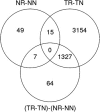New specific molecular targets for radio-chemotherapy of rectal cancer
- PMID: 19969511
- PMCID: PMC5527962
- DOI: 10.1016/j.molonc.2009.11.002
New specific molecular targets for radio-chemotherapy of rectal cancer
Abstract
Patients with locally advanced rectal cancer often receive preoperative radio-chemotherapy (RCT). The mechanisms of tumour response to radiotherapy are not understood. The aim of this study was to identify the effects of RCT on gene expression in rectal tumour and normal rectal tissue. For that purpose tissue samples from 21 patients with resectable adenocarcinomas were collected for use in whole genome-microarray based gene expression analysis. A factorial experimental design allowed us to determine the effect of RCT on tumour tissue alone by removing the effect of radiation on normal tissue. This resulted in 1327 differentially expressed genes in tumour tissue with p<0.05. In addition to known markers for radio-chemotherapy, a Gene Set Enrichment Analysis (GSEA) showed a significant enrichment in gene sets associated with cell adhesion and leukocyte transendothelial migration. The profound change of cell adhesion molecule expression in rectal tumour tissue could either increase the risk of metastasis, or decrease the tumour's invasive potential.
Figures






Similar articles
-
Effectiveness of gene expression profiling for response prediction of rectal adenocarcinomas to preoperative chemoradiotherapy.J Clin Oncol. 2005 Mar 20;23(9):1826-38. doi: 10.1200/JCO.2005.00.406. J Clin Oncol. 2005. PMID: 15774776 Free PMC article. Clinical Trial.
-
p53, deleted in colorectal cancer gene, and thymidylate synthase as predictors of histopathologic response and survival in low, locally advanced rectal cancer treated with preoperative adjuvant therapy.Dis Colon Rectum. 2003 Feb;46(2):192-202. doi: 10.1007/s10350-004-6524-2. Dis Colon Rectum. 2003. PMID: 12576893
-
Pretreatment transcriptional profiling for predicting response to neoadjuvant chemoradiotherapy in rectal adenocarcinoma.Clin Cancer Res. 2011 May 1;17(9):3039-47. doi: 10.1158/1078-0432.CCR-10-2915. Epub 2011 Jan 11. Clin Cancer Res. 2011. PMID: 21224373
-
Five fractions of preoperative radiotherapy for selected cases of rectal cancer.Tech Coloproctol. 2004 Nov;8 Suppl 1:s36-8. doi: 10.1007/s10151-004-0106-0. Tech Coloproctol. 2004. PMID: 15655637 Review.
-
Role of radiation therapy in the treatment of resectable rectal adenocarcinoma.J Surg Oncol. 2002 Feb;79(2):107-17; discussion 118. doi: 10.1002/jso.10048. J Surg Oncol. 2002. PMID: 11815998 Review.
Cited by
-
Long Intergenic Non-Coding RNAs of Human Chromosome 18: Focus on Cancers.Biomedicines. 2024 Feb 28;12(3):544. doi: 10.3390/biomedicines12030544. Biomedicines. 2024. PMID: 38540157 Free PMC article. Review.
-
MicroRNA-144 mediates chronic inflammation and tumorigenesis in colorectal cancer progression via regulating C-X-C motif chemokine ligand 11.Exp Ther Med. 2018 Sep;16(3):1935-1943. doi: 10.3892/etm.2018.6389. Epub 2018 Jul 2. Exp Ther Med. 2018. PMID: 30186421 Free PMC article.
-
Topoisomerase I inhibition in colorectal cancer: biomarkers and therapeutic targets.Br J Cancer. 2012 Jan 3;106(1):18-24. doi: 10.1038/bjc.2011.498. Epub 2011 Nov 22. Br J Cancer. 2012. PMID: 22108516 Free PMC article. Review.
-
Radiation-induced changes in gene expression in rectal cancer specimens.Clin Transl Oncol. 2024 Jun;26(6):1419-1428. doi: 10.1007/s12094-023-03361-9. Epub 2024 Jan 19. Clin Transl Oncol. 2024. PMID: 38243085 Free PMC article. Review.
-
Introducing novel key genes and transcription factors associated with rectal cancer response to chemoradiation through co-expression network analysis.Heliyon. 2023 Aug 2;9(8):e18869. doi: 10.1016/j.heliyon.2023.e18869. eCollection 2023 Aug. Heliyon. 2023. PMID: 37636389 Free PMC article.
References
-
- Akimoto, T. , Mitsuhashi, N. , Saito, Y. , Ebara, T. , Niibe, H. , 1998. Effect of radiation on the expression of E-cadherin and α-catenin and invasive capacity in human lung cancer cell line in vitro . Int. J. Radiat. Oncol. Biol. Phys. 41, 1171–1176. - PubMed
-
- Baluna, R.G. , Eng, T.Y. , Thomas, C.R. , 2006. Adhesion molecules in radiotherapy. Radiation Research. 166, 819–831. - PubMed
-
- Barcellos-Hoff, M.H. , Park, C. , Wright, E.G. , 2005. Radiation and the microenvironment-tumorigenesis and therapy. Nat. Rev. Cancer. 5, 867–875. - PubMed
-
- Benjamini, Y. , Hochberg, Y. , 1995. Controlling the false discovery rate: a practical and powerful approach to multiple testing. J.R. Stat. Soc. Ser. B. 57, 289–300.
Publication types
MeSH terms
Substances
LinkOut - more resources
Full Text Sources
Molecular Biology Databases

